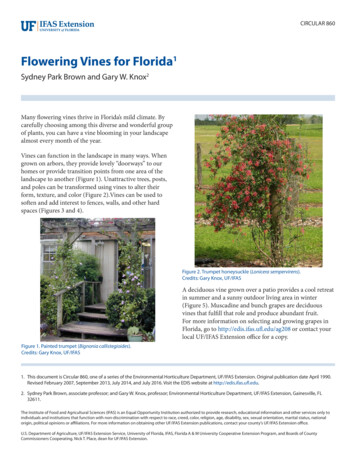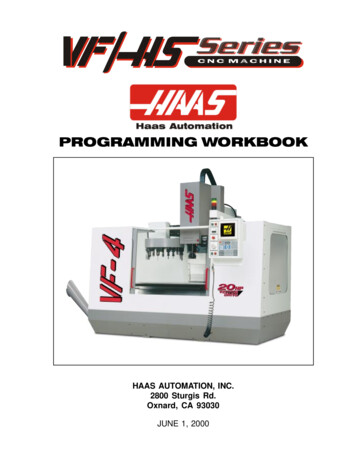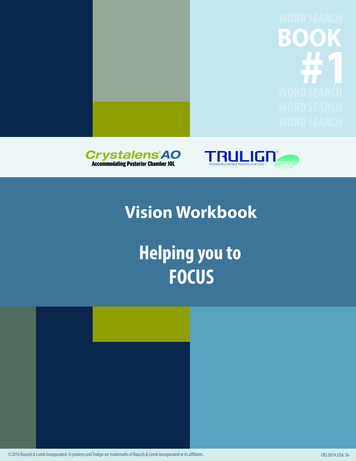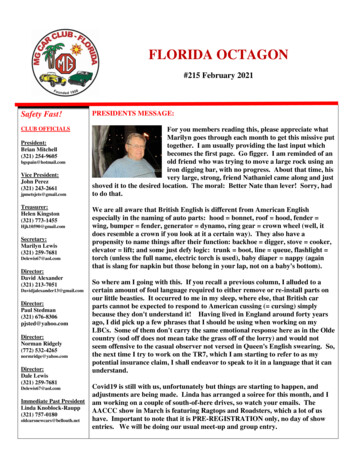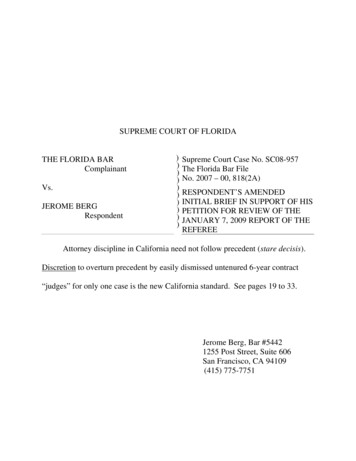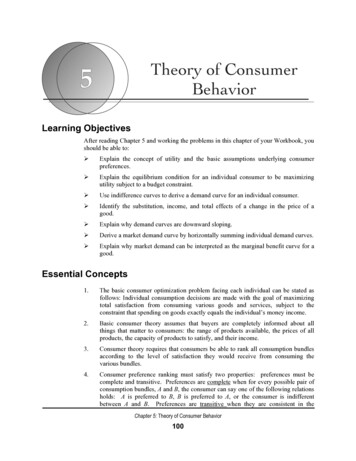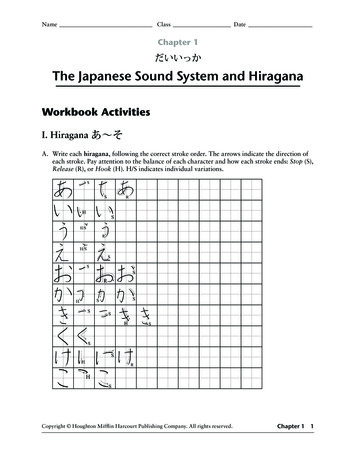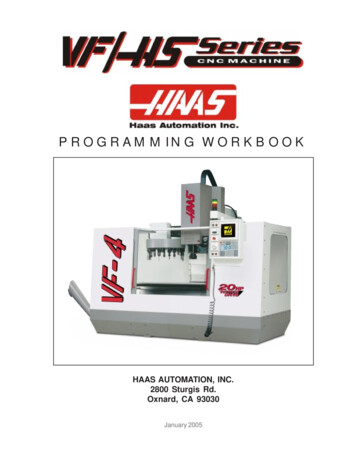
Transcription
PROGRAMMING WORKBOOKHAAS AUTOMATION, INC.2800 Sturgis Rd.Oxnard, CA 93030January 2005
JANUARY 2005PROGRAMMINGHAAS AUTOMATION INC.2800 Sturgis RoadOxnard, California 93030Phone: 805-278-1800www.HaasCNC.comThe information in this workbook is reviewed regularly and any necessary changes will be incorporated in the next revision. This material is subject to change without notice.Warning: This workbook is for the exclusive use of Haas Customers, Distributors and Trainersand is protected by copyright law. The reproduction, transmission or use of this document or itscontents for profit is not permitted.All content is the property of Haas Automation, Inc., copyright 2004-2005. This Workbook maynot be copied,distributed or reproduced for profit, in full or in part, without written permissionfrom Haas Automation, Inc. This training information is being supplied for free to all Haascustomers and schools that are learning to use Haas equipment. Haas information should neverbe modified unless you have written permission by Haas Automation.Enquiries to Haas Automation about training information or a letter of authorization to copy,contact ebowman@haascnc.comCopyright 2005, Haas AutomationI
JANUARY 2005PROGRAMMINGCUSTOMER SATISFACTION PROCEDUREDear Haas customer,Your complete satisfaction and goodwill are of the utmost importance to both Haas Automation,Inc., and the Haas distributor where you purchased your equipment. Normally, any concerns youmay have about the sales transaction or the operation of your equipment will be rapidly resolvedby your distributor.However, if your concerns are not resolved to your complete satisfaction, and you have discussed your concerns with a member of the dealership’s management, the General Manager orthe dealership’s owner directly, please do the following:Contact Haas Automation’s Customer Service Center by calling 800-331-6746 and ask for theCustomer Service Department. So that we may resolve your concerns as quickly as possible,please have the following information available when you call: Your name, company name, address and phone numberThe machine model and serial numberThe dealership name, and the name of your latest contact at the dealershipThe nature of your concernIf you wish to write Haas Automation, please use this address:Haas Automation, Inc.2800 Sturgis RoadOxnard, CA 93030Att: Customer Satisfaction Managere-mail: Service@HaasCNC.comOnce you contact the Haas Automation Customer Service Center, we will make every effort towork directly with you and your distributor to quickly resolve your concerns. At Haas Automation,we know that a good Customer-Distributor-Manufacturer relationship will help ensure continuedsuccess for all concerned.NOTE:Should you have a problem with your machine, please consult your operator's manualfirst. If this does not resolve the problem, call your authorized Haas distributor. As a final solution, call Haas directly at the number indicated below.Haas Automation, Inc.2800 Sturgis RoadOxnard, California 93030-8933Phone: (805) 278-1800IIUSA
JANUARY 2005PROGRAMMINGCONTENTSINTRODUCTION . 1THE COORDINATE SYSTEM . 2MACHINE HOME . 5ABSOLUTE AND INCREMENTAL POSITIONING . 6POSITIONING EXERCISE . 8PROGRAMMING WITH CODES . 9PROGRAM FORMAT . 10DEFINITIONS WITHIN THE FORMAT . 11OFTEN USED PREPARATORY "G" CODES . 13PREPARATORY "G" CODES LIST . 14MACHINE DEFAULTS . 18OFTEN USED MISCELLANEOUS "M" CODES . 19MISCELLANEOUS "M" CODES LIST . 20PROGRAM STRUCTURE . 22ALPHABETICAL ADDRESS CODES . 24RAPID POSITION COMMAND (G00) . 28LINEAR INTERPOLATION COMMAND (G01) . 29CIRCULAR INTERPOLATION COMMANDS (G02, G03) . 30INTERPOLATION EXERCISE . 39PROGRAM START-UP LINES . 40PROGRAM ENDING LINES. 41INCH / METRIC SELECTION (G20, G21) . 42WORK COORDINATE SELECTION (G54-59, G110-129 & G154 with P1-99) . 43MORE WORK COORDINATE SELECTION (G52, G53,) . 44TOOL LENGTH COMPENSATION (G43). 45DWELL COMMAND (G04) . 46REFERENCE POINT AND RETURN (G28) . 47ANOTHER WAY TO RETURN TO MACHINE ZERO (G53) . 48CIRCULAR POCKET MILLING (G12, G13). 49CIRCULAR POCKET MILLING EXERCISE . 53III
JANUARY 2005PROGRAMMINGCONTENTSCIRCULAR PLANE SELECTION (G17, G18, G19) . 54CUTTER COMPENSATION (G40, G41, G42) . 58CUTTER COMPENSATION EXERCISE #1 . 64ADVANTAGES OF CUTTER COMPENSATION . 65CUTTER COMPENSATION EXERCISE #2 . 66THREAD MILLING WITH HELICAL MOTION . 68CANNED CYCLES FOR DRILLING TAPPING AND BORING . 70CANCEL CANNED CYCLE (G80) . 71CANNED CYCLE RETURN PLANES (G98, G99) . 72DRILL CANNED CYCLE (G81) . 73SPOT DRILL/COUNTERBORE CANNED CYCLE (G82) . 74DEEP HOLE PECK DRILL CANNED CYCLE (G83) . 75CANNED CYCLE EXERCISE #1 . 78TAPPING CANNED CYCLE (G84) . 80BORE IN - BORE OUT CANNED CYCLE (G85) . 81BORE IN - STOP - RAPID OUT CANNED CYCLE (G86) . 82BORE IN - MANUAL RETRACT CANNED CYCLE (G87) . 83BORE IN - DWELL - MANUAL RETRACT CANNED CYCLE (G88) . 84BORE IN - DWELL - BORE OUT CANNED CYCLE (G89) . 85CANNED CYCLE EXERCISE #2 . 86HIGH SPEED PECK DRILL CANNED CYCLE (G73) . 88REVERSE TAPPING CANNED CYCLE (G74) . 92BORE IN - SHIFT OFF - RAPID OUT CANNED CYCLE (G76) . 93BACK BORE CANNED CYCLE (G77) . 94BOLT HOLE PATTERNS (G70, G71, G72) . 95BOLT HOLE CIRCLE (G70) . 96BOLT HOLE ARC (G71) . 97BOLT HOLES ALONG AN ANGLE (G72) . 98CANNED CYCLE EXERCISE #3 . 100SUBROUTINE (M97, M98, M99) . 103IV
JANUARY 2005PROGRAMMINGCONTENTSGENERAL PURPOSE POCKET MILLING (G150) . 107MISCELLANEOUS "M" CODES . 114FINAL EXERCISE . 128V
PROGRAMMINGVIJANUARY 2005
JANUARY 2005PROGRAMMINGINTRODUCTIONThis manual provides basic programming principles necessary to begin programming theHAAS C.N.C. Milling Machine.In a “CNC” (Computerized Numerical Control) machine, the tool is controlled by acomputer and is programmed with a machine code system that enables it to be operatedwith minimal supervision and with a great deal of repeatability.The same principles used in operating a manual machine are used in programming a CNCmachine. The main difference is that instead of cranking handles to position a slide to acertain point, the dimension is stored in the memory of the machine control once. Thecontrol will then move the machine to these positions each time the program is run.In order to operate and program a CNC controlled machine, a basic understanding ofmachining practices and a working knowledge of math is necessary. It is also importantto become familiar with the control console and the placement of the keys, switches,displays, etc., that are pertinent to the operation of the machine.This workbook can be used for both operator’s and programmer’s. It is intended to givea basic understanding of CNC programming and it’s applications. It is not intended as anin-depth study of all ranges of machine use, but as an overview of common and potentialsituations facing CNC programmers. Much more training and information is necessarybefore attempting to program on the machine.This programming manual is meant as a supplementary teaching aid to users of the HAASMill. The information in this workbook may apply in whole or in part to the operation of otherCNC machines. Its use is intended only as an aid in the operation of the HAAS MillingMachine. For a complete explanation and an in-depth description, refer to the Programming and Operation Manual that is supplied with your HAAS Mill.1
PROGRAMMINGJANUARY 2005THE COORDINATE SYSTEMThe first diagram we are concerned with is called a NUMBER LINE. This number line hasa zero reference point that is called an ABSOLUTE ZERO and may be placed at any pointalong the number line.Horizontal number lineThe number line also has numbered increments on either side of absolute zero.Moving away from zero to the right are positive increments. Moving away fromzero to the left are negative increments. The “ ”, or positive increments, areunderstood, therefore no sign is needed. We use positive and negative signsalong with increment value's to indicate its relationship to zero on the line. If wechoose to move to the third increment on the minus (-) side of zero, we would callfor -3. If we choose the second increment in the plus range, we would call for 2.Our concern is the distance and the direction from zero.Remember that zero may be placed at any point along the line, and that onceplaced, one side of zero has negative increments and the other side has positiveincrements.Vertical number lineThe machine illustration shows threedirections of travel available on a verticalmachine center. To carry the number lineidea a little further, imagine such a lineplaced along each axis of the machine. Itshows the three directions to position thecoordinates around a part origin, whichis where these number lines intersect ona vertical machining center with the X, Y,and Z axis lines.The first number line is easy to conceiveas belonging to the left-to-right, or “X”,axis of the machine. If we place a similarnumber line along the front-to-back, or“Y” axis, the increments (not the table)toward the operator, from Y zero, are thenegative increments. The increments onthe other side of zero away from theoperator are positive increments.The third axis of travel on our machine is the up-and-down, or “Z” axis. When we place anumber line on the Z travel, the positive increments are up above zero, and the negative2
JANUARY 2005PROGRAMMINGvalues are down below zero. The increments
The same principles used in operating a manual machine are used in programming a CNC machine. The main difference is that instead of cranking handles to position a slide to a certain point, the dimension is stored in the memory of the machine control once. The control will then move the machine to these positions each time the program is run. In order to operate and program a CNC controlled .
